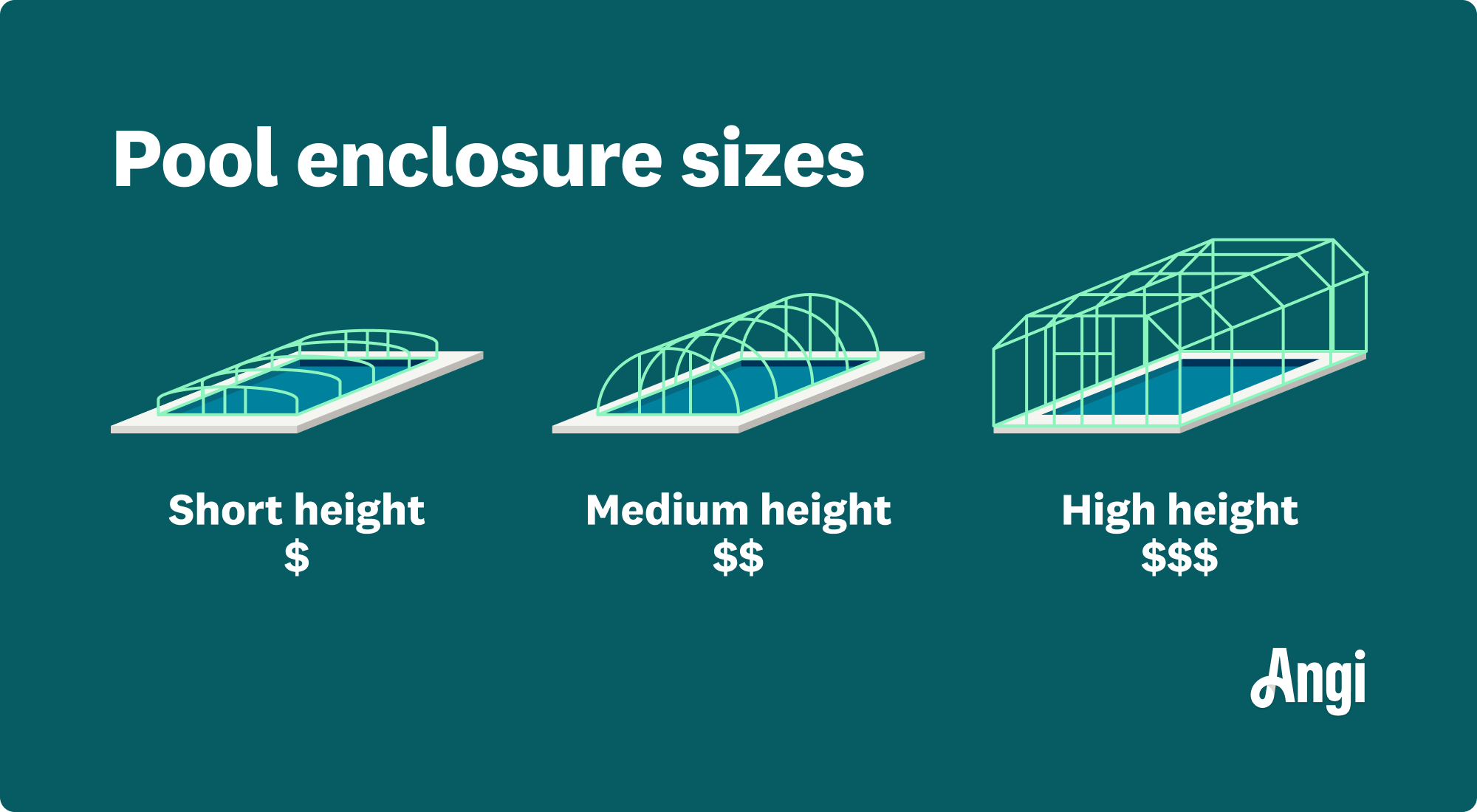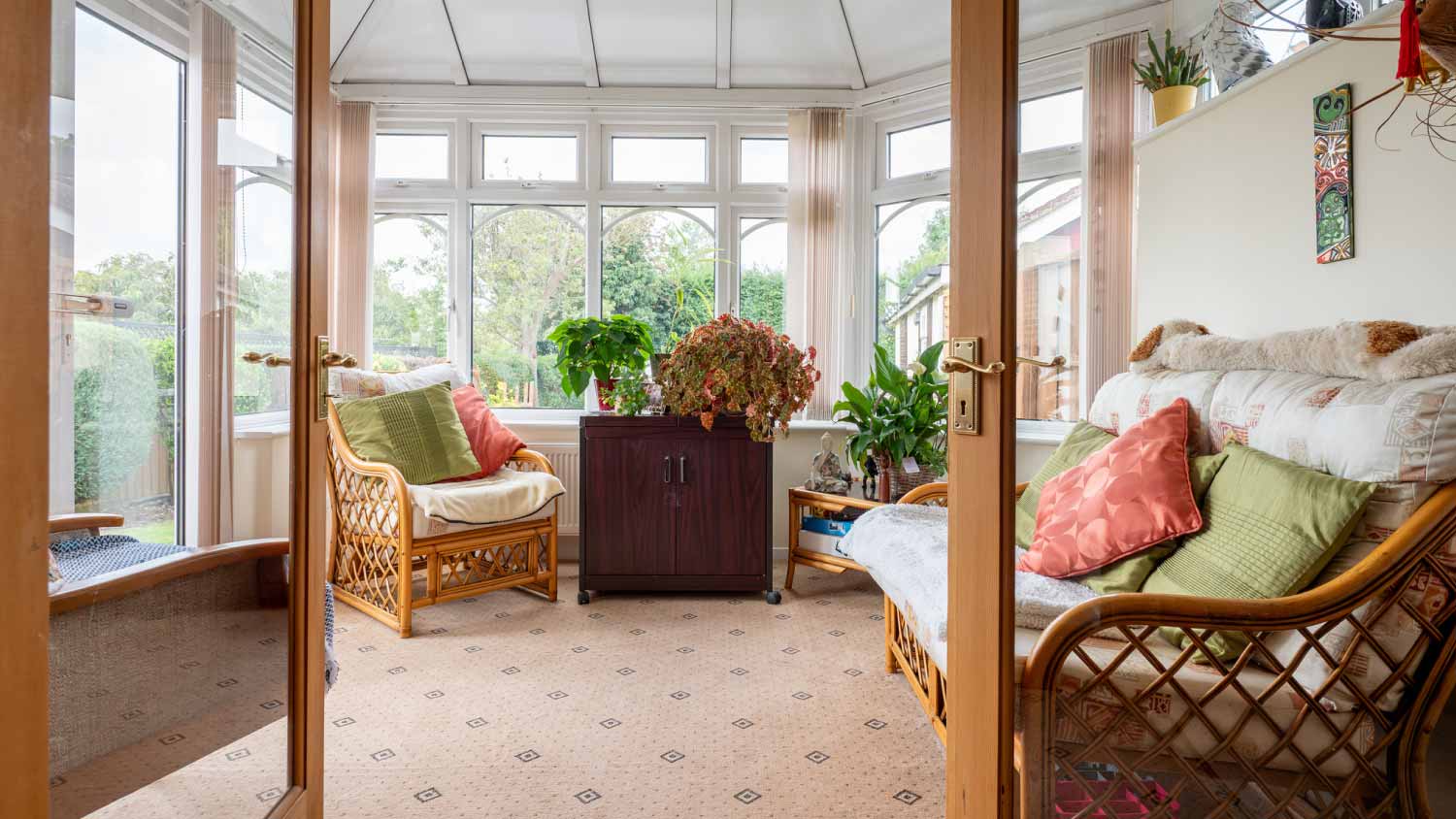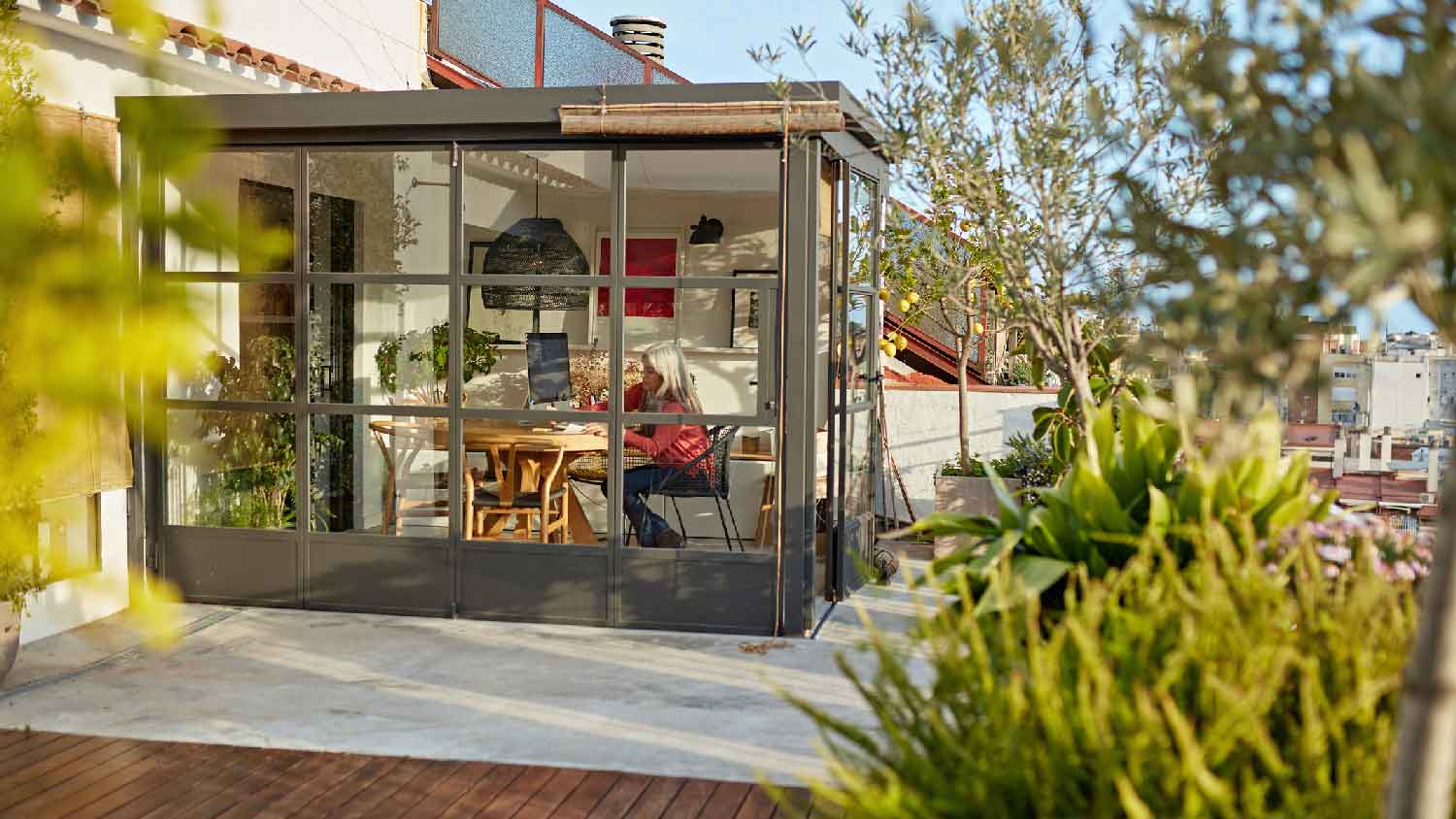
Considering adding a screened porch to your home? Discover the average cost of a screened-in porch, depending on its size, location, and more.
Sunroom and patio service costs depend on your project and location. Check with a local pro for your specific job.
The cost of a pool enclosure varies by size, with low-height enclosures costing $24 to $75 per square foot and high-height enclosures costing $15 to $200 per square foot.
A screen pool enclosure will cost $8 to $15 per square foot, but you may pay up to $200 per square foot for a polycarbonate option.
Expect to pay $35 to $50 per hour in labor fees.
Other cost factors include door type, framing, glazing, design, brand, and more.
Maybe you’re tired of fending off critters or finding dirt and sticks by the pool. While the average cost is {{nationalAvgCost}} to install a pool enclosure, the average enclosure falls between {{nationalAvgRangeMinCost}} and {{nationalAvgRangeMaxCost}}. Read more below for all the cost factors that may impact the price of your project.

Here are some of the important costs of screened-in pools that you should consider when prepping for the project.

A low pool enclosure typically costs roughly $24 to $75 per square foot, and usually solely covers the pool. A low-height enclosure typically ranges from one to two feet above the pool surface. These are the simplest option, made to offer security and help keep the pool clean.
Medium-sized pool enclosures on average cost somewhere between $8 and $100 per square foot, and are one of the most commonly picked enclosures. A medium-height enclosure usually ranges from two to three feet above the pool surface. These enclosures may be screened in, only covering the pool, or can be larger enclosures and cover some of the deck and seating areas
High-height enclosures tend to cost around $15 to $200 per square foot, and are usually as tall as full ceiling height. You can expect a high pool enclosure to be around three to four feet above the pool surface. Homeowners often request custom paneling and parts that can be opened for airflow.
Common pool enclosure materials include screen, polycarbonate, and glass. Here is a look at each of those three options.
Screen: Pool screen enclosures typically cost around $8 to $15 per square foot. These are great for warding off bugs, leaves, and debris. There are various options for screen types, such as fiberglass screens, pet screens (these are made to prevent pets from gripping the screen), and “Florida Glass” (a screen with a clear plastic overlay offering protection from outdoor elements).
Polycarbonate: Polycarbonate enclosures, on average, cost between $20 and $200 per square foot. These enclosures provide a line of defense against outdoor elements and keep out debris and intruders. Plus, polycarbonate offers protection against UV rays. Polycarbonate enclosures are also versatile, coming in all types of shapes and sizes.
Glass: As the most expensive option, glass pool enclosures cost roughly $30 to $75 per square foot. These enclosures are made of glass panels, which are usually tempered and insulated—this insulation and temperance offer more security and energy efficiency. One downside is that these enclosures aren’t available in all shapes, like polycarbonate enclosures.
| Pool Enclosure Material Type | Average Cost (Per Square Foot) |
|---|---|
| Screen | $8–$15 |
| Polycarbonate | $20–$200 |
| Glass | $30–$75 |
The price of your enclosure door will depend on the type of door you pick. The most common pool enclosure doors are screen doors, storm doors, and doggy doors.
Screen pool doors are the most inexpensive option, usually ranging from around $50 to $500. These may be single or double doors and can be decorative or plain. The frame is usually aluminum, but may sometimes be wood.
Storm doors are usually made of polycarbonate and tend to be clear or opaque, which allows some light in. These range from $100 to $1,000 on average. Storm doors are usually a little more secure than screen doors, and you can enhance security by attaching a security lock.
The most expensive option, a doggy door, typically costs somewhere from around $150 to $500. These are very versatile and can be made in several different sizes and materials.
If your main interest is to keep debris and critters out of your pool, you can buy a pool cover. The three main types of pool covers are safety pool covers, solar pool covers, and winter pool covers. Pool covers cost $100 or more and come in different materials.
| Door Type | Average Cost |
|---|---|
| Screen | $50–$500 |
| Storm | $100–$1,000 |
| Doggy | $150–$500 |
| Standard pool cover | $100+ |
On average, you can expect to pay around $35 per hour for pool enclosures that are screen and polycarbonate, while glass enclosures labor rates tend to be slightly higher at around $50 per hour.
If you live in areas that experience high snow and winds, you’ll probably need to install a more heavy-duty enclosure. This may include a larger enclosure or more sturdy material, and will increase the total project cost. On average, this will increase the cost by roughly 10%.
For those living in areas with extreme weather conditions (hurricanes, strong winds, heavy snow), the pool enclosure should be a bit stronger. This may include adding framing and glaze to your enclosure.
On average, a screen mesh or aluminum framing costs roughly $5 to $15. If you’re adding a glaze, which helps protect the enclosure, you can expect the total cost to increase by around 10%.
If your pool is far from your home, then you’ll need a freestanding enclosure, meaning that none of the enclosure walls share a wall with your house. These are sometimes called lean-to enclosures, and they cost $5,000 to $20,000.
Attached pool closures have three walls and use one wall of your house. These range from $5,000 to $50,000. There are many different attached enclosure types, including shed roof, hip roof, mansard, and gable enclosures.
For those working with a budget, consider freestanding, portable enclosures. These cost $750 to $7,500.
Pool enclosure kits give you the chance to DIY the job. These cost $600 to $15,000 depending on the pool size and material type. This cost doesn’t account for hiring any pros to help put everything together, it’s just for the materials only.
On the other end of the price range are the custom-build enclosures, which range between $20,000 to $200,000. You might go with a custom enclosure if you’re looking for something that seamlessly matches your house design, or if your pool is an unusual shape or size.
There are a variety of pool enclosure designs to choose from. Here are some of the most common ones and their respective costs.
Domed pool enclosures on average cost $1,200, with a range of roughly $870 to $1,500. These can be simple and low, or more complex and large. They are available in a wide range of costs, sizes, and styles, but usually are made of polycarbonate.
Lean-to pool enclosures extend off your home and contain three walls. If you want to be able to go directly out of your home into your enclosure, a lean-to enclosure is a great option. A lean-to enclosure on average costs $5,000 to $20,000, and can be made of many materials such as screen, glass, and polycarbonate.
According to HomeAdvisor, retractable pool enclosures cost an average of $70,000 for a 700-square foot area, but can range up to $140,000. Most of the time, these enclosures are made of polycarbonate, but some have glass panels or consist of a mix of glass and polycarbonate. Some have panels which slide from one end to the other, while others have motorized panels, which can increase total project cost.
There are a number of popular brands that create pool enclosures with varying costs and installation rates.
You can expect Libart enclosures to cost between $75 and $200 per square foot. These are available in several customizable styles, and you can choose the height of your liking. Plus, they’re available in different shapes and styles. These are made from aluminum and polycarbonate materials and are strong and long-lasting.
DynaDome enclosures also cost on average between $75 and $200 per square foot and also are available in a long list of customizable styles.
Roll-a-Cover pool enclosures are the slightly more expensive option, usually ranging from around $80 to $120 per square foot. These come in many styles and are lightweight, durable, and easy to transfer and maintain.
Building a pool enclosure yourself may save $35 to $50 per hour in labor fees, but the job involves precise measuring, structural engineering, permitting, and handling heavy materials. Even prefabricated kits can be challenging for the average homeowner. It’s often best to hire a pool enclosure or sunroom installer near you to tackle this job.
Most homeowners should hire a pro to install a pool enclosure for these reasons:
Experienced contractors will ensure compliance with local building codes and permitting requirements—and they’ll also obtain the permits for you.
Pros take accurate measurements to prevent misalignment, sagging, warping, or structural instability.
Installing a pool enclosure requires specialized tools and equipment.
Trained installers may notice potential drainage or foundation issues before beginning the installation.
Pros can recommend the right materials for your climate, which ensures proper stability, energy efficiency, and UV protection.
Reputable contractors offer warranties on both materials and labor.
Homeowners may be able to assist with a few manageable tasks, including the following:
Clear the site of debris, furniture, and landscaping to prepare the workspace
Trim nearby bushes and shrubs so the installers have easy access
Verify property lines or HOA restrictions ahead of time (if applicable)
Handle minor prep work, such as cleaning the pool deck
Add finishing touches after installation, such as decor, lighting, and poolside accessories
If you’re really up for the challenge, here’s how to build a pool enclosure on your own.
If you’re getting a new pool enclosure, you may want to consider installing or upgrading additional features. For example, factoring in pool fence costs will provide benefits like increased safety and security.
| Pool Enclosure Add-Ons | Average Cost |
|---|---|
| Lighting | $625 each |
| Landscaping | $1,270–$6,000 |
| HVAC upgrades | $1,600–$5,200 |
| Drainage | $240–$1,130 |
| Pool fence | $15–$25 per linear foot |
| Seating or storage | $500–$2,000 |
| Furniture and accessories | $500–$2,000 |
Discuss the best materials for your pool enclosure given your climate, needs, and budget.
Ask about the maintenance requirements for long-term care.
Ensure the contractor will obtain the proper permits and comply with local building codes.
Review the project timeline, cost estimates, and access needs for your property.
Home is the most important place on earth, which is why Angi has helped more than 150 million homeowners transform their houses into homes they adore. To help homeowners with their next project, Angi provides readers with the most accurate cost data and upholds strict editorial standards. We survey real Angi customers about their project costs to develop the pricing data you see, so you can make the best decisions for you and your home. We pair this data with research from reputable sources, including the U.S. Bureau of Labor Statistics, academic journals, market studies, and interviews with industry experts—all to ensure our prices reflect real-world projects.
Want to help us improve our cost data? Send us a recent project quote to [email protected]. Quotes and personal information will not be shared publicly.
From average costs to expert advice, get all the answers you need to get your job done.

Considering adding a screened porch to your home? Discover the average cost of a screened-in porch, depending on its size, location, and more.

Homeowners can enclose their porches in a few different ways—each having their own price tag. Learn what contributes to the total cost to enclose a porch and how you can reduce the bill.

Love soaking up sun but can’t stand the bugs? Learn how much a Florida room addition costs and what factors influence the price to get the best of both worlds.

Not sure if you’d prefer a sunroom vs. a screened porch? Use this comprehensive guide to help you decide which you’d get more value from in the long run.

A screened-in porch lets you enjoy the outdoors while being protected from bugs and direct sun. Learn the pros and cons of a screened-in porch.

Enjoy the outdoors without being exposed to the elements with an Arizona room. Learn what an Arizona room is and why it may be a great addition to your home.